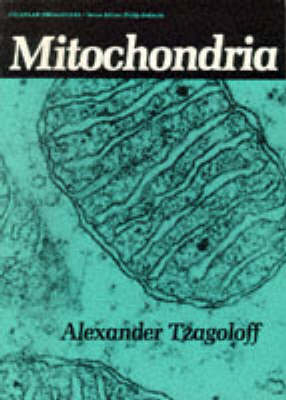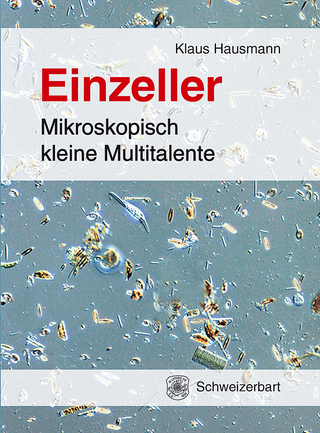
Mitochondria
Kluwer Academic / Plenum Publishers (Verlag)
978-0-306-40778-9 (ISBN)
- Titel ist leider vergriffen;
keine Neuauflage - Artikel merken
Con- sistent with the original aim, literature citations have been kept to a minimum and are avoided in the main body of the text for purposes of readability.
1 Evolution of Mitochondrial Studies.- I. Early Cytological Studies (1850-1900).- II. Early Studies of Biological Oxidation Reactions (1900-1940).- III. Identification of Mitochondria as Centers of Energy Metabolism (1940-1950).- IV. Gross and Fine Structure of Mitochondria.- V. Electron Transfer.- VI. Oxidative Phosphorylation.- VII. Biogenesis and Genetics of Mitochondria.- Selected Readings.- 2 Mitochondrial Structure and Compartmentalization.- I. Gross Morphology of Mitochondria.- A. Fixed and Stained Thin Sections.- B. Orthodox versus Condensed Conformations.- C. Mitochondria as Seen in Live Cells.- D. Mitochondria with Unusual Morphologies.- II. Subfractionation of Mitochondria.- A. Osmotic Method.- B. Digitonin Method.- C. Fractionation of Mitochondria into Soluble and Membrane Components.- III. Distribution of Mitochondrial Enzymes.- A. Outer Membrane.- B. Inner Membrane.- C. Intermembrane Space.- D. Matrix.- IV. Composition of the Inner and Outer Membranes.- A. Lipid Constituents.- B. Protein Constituents.- V. Current Views on the Structure of Biological Membranes.- VI. Fine Structure of Mitochondrial Membranes.- A. Ultrastructure in Thin Sections.- B. Ultrastructure in Negative Staining.- C. Ultrastructure in Freeze-Etching.- Selected Readings.- 3 Oxidative Pathways of Mitochondria.- I. Conversion of Pyruvic Acid to Acetyl-CoA.- A. Structure of the Pyruvate Dehydrogenase Complex.- B. Regulation of the Mammalian Pyruvate Dehydrogenase Complex.- II. ?-Oxidation of Fatty Acids.- A. Entry of Fatty Acids into the Mitochondrion.- B. Enzymes of ?-Oxidation.- C. Ancillary Enzymes of ?-Oxidation.- III. Utilization of Ketone Bodies.- IV. Metabolism of Amino Acids.- A. Amino Acids as a Source of Acetyl-CoA.- B. Amino Acids as a Source of Tricarboxylic Acid Cycle Intermediates.- C. The Glutamate Cycle.- V. Tricarboxylic Acid Cycle.- A. Enzymes of the Tricarboxylic Acid Cycle.- B. Regulation of the Tricarboxylic Acid Cycle.- VI. Yield of ATP from the Aerobic Oxidation of Glucose.- A. Free Energy Change of ATP Hydrolysis.- B. ATP Yield from Glucose.- Selected Readings.- 4 The Electron Transfer Chain.- I. Carriers of the Electron Transfer Chain.- A. Flavoenzymes.- B. Cytochromes.- C. Metalloproteins.- D. Low-Molecular-Weight Carriers.- II. Redox Potentials of the Electron Transfer Chain Carriers.- III. Sequence of Electron Transfer Carriers Based on their Rates of Oxidation and Reduction.- A. Cytochrome Chain.- B. Placement of the Iron-Sulfur Centers.- C. Placement of Copper.- D. Placement of Coenzyme Q.- E. Deduced Sequence of Electron Transfer Carriers Based on their Kinetic Properties.- IV. Inhibitors of Electron Transfer.- A. Cyanide and Carbon Monoxide.- B. Antimycin A.- C. Rotenone, Piericidin, Amobarbital.- V. Properties of the Respiratory Complexes.- A. Purification of Respiratory Complexes.- B. Compositions and Enzymatic Properties of the Respiratory Complexes.- VI. Stoichiometry of the Electron Transfer Carriers.- VII. Other Respiratory Chain-Linked Dehydrogenases.- Selected Readings.- 5 Cytochrome Oxidase: Model of a Membrane Enzyme.- I. Purification and Assay of Cytochrome Oxidase.- II. Structure of Cytochrome Oxidase.- A. Subunit Composition.- B. Purification of Subunits and Identity with Known Carriers.- C. Quaternary Structure.- III. Formation of Cytochrome Oxidase Membranes.- IV. Shape of Cytochrome Oxidase.- V. Phospholipid Activation of Enzymatic Activity.- VI. Mechanism of Catalysis.- Selected Readings.- 6 Oxidative Phosphorylation.- I. The Concept of Coupling.- II. Uncouplers and Inhibitors of Oxidative Phosphorylation.- III. Efficiency of Phosphorylation.- IV. Phosphorylation Sites.- A. Crossover Points.- B. Site-Specific Assays.- V. Evidence for the Existence of a Nonphosphorylated Intermediate.- VI. Partial Reactions of Oxidative Phosphorylation.- A. ATP-Pi Exchange.- B. ATP-ADP Exchange.- C. ATP-H218O Exchange.- D. Pi-H218O Exchange.- VII. Role of Structure in Oxidative Phosphorylation.- VIII. Current Theories of the Coupling Mechanism.- A. Chemical Hypothesis.- B. Chemiosmotic Hypothesis.- C. Conformational Hypothesis.- Selected Readings.- 7 The Mitochondrial Adenosine Triphosphatase.- I. Purification and Properties of the ATPase Complex.- A. Mammalian ATPase.- B. Yeast ATPase.- C. Enzymatic Properties of the Oligomycin-Sensitive ATPase.- D. Subunit Polypeptides of the Oligomycin-Sensitive ATPase.- II. Functional Components of the ATPase Complex.- A. F1 ATPase.- B. Membrane Factor.- C. Oligomycin-Sensitivity-Conferring Protein.- III. Ultrastructure of the ATPase.- IV. Catalytic Mechanism of the ATPase.- V. Coupling Factor Activity of ATPase Components.- A. F1.- B. Coupling Factors That Are Related to F1.- C. Oligomycin-Sensitivity-Conferring Protein.- D. F6.- E. Factor B.- F. Present Status of Coupling Factors.- Selected Readings.- 8 Resolution and Reconstitution of Electron Transport and Oxidative Phosphorylation.- I. Electron Transport Chain.- II. Reconstitution of the Electron Transfer Complexes.- III. Resolution of Oxidative Phosphorylation in Submitochondrial Particles.- IV. Reconstitution of a Coupled ATPase Membrane.- V. Reconstitution of Coupled Electron Transport Membranes.- VI. Reconstitution of Oxidative Phosphorylation.- Selected Readings.- 9 Mitochondrial Transport Systems.- I. Some General Considerations of How Molecules Cross Biological Membranes.- A. Facilitated Diffusion.- B. Active Transport.- C. Group Translocation.- II. Methodology for Studying Mitochondrial Transport.- A. Direct Measurements of Substrate Concentration.- B. Mitochondrial Swelling.- C. Oxidation of Substrates.- III. Passive Diffusion of Gases and Water.- A. Water.- B. Oxygen.- C. Carbon Dioxide.- IV. Mechanisms of Substrate Transport in Mitochondria.- A. Passive Diffusion.- B. Carrier-Mediated Transport.- C. Energy-Coupled Transport.- V. Transport of Specific Substrates.- A. Anions.- B. Amino Acids.- C. Fatty Acids.- VI. Substrate Transport and Coordination of Mitochondrial and Cytoplasmic Metabolism.- A. Shuttles that Oxidize External NADH.- B. Transport Systems that Function in Gluconeogenesis and Ureogenesis.- VII. Metal Transport.- A. Ionophores.- B. Mechanisms of Metal Transport.- Selected Readings.- 10 Mitochondrial Biogenesis.- I. Mitochondrial Continuity.- II. Components of the Mitochondrial Translation Machinery.- A. Mitochondrial Ribosomes.- B. Transfer RNAs.- C. Aminoacyl Synthetases.- III. Mitochondrial Protein Synthesis.- A. In Vitro.- B. in Vivo.- C. Number of Mitochondrial Products.- D. Identification of the Mitochondrial Translation Products.- E. Properties of Mitochondrially Synthesized Proteins.- IV. Phospholipid Biosynthesis.- V. Nuclear Gene Products.- A. Nuclear Structural Genes.- B. Nuclear Regulation of the Mitochondrial Genome.- VI. Transport of Proteins into Mitochondria.- A. Transport of Cytochrome c.- B. Internalization of Mitochondrial Proteins.- VII. Biosynthesis of Inner Membrane Enzymes.- A. Oligomycin-Sensitive ATPase.- B. Cytochrome Oxidase.- C. Other Membrane Constituents.- Selected Readings.- 11 Mitochondrial Genetics.- I. Mitochondrial DNA.- II. Life Cycle of Saccharomyces cerevisiae.- III. Genetic Criteria for Distinguishing Nuclear and Mitochondrial Mutations.- A. Restoration of Wild-Type Growth by a ?0 Tester.- B. Meiotic Segregation.- C. Mitotic Segregation.- IV. Mitochondrial Genes and Mutants.- A. Genes.- B. Mutants.- V. Genetic Methods for Mapping Mitochondrial Mutations.- A. Loci on Mitochondrial DNA.- B. Mapping of Mitochondrial Markers by Recombination.- C. Mapping of Mitochondrial Mutations with ?? Clones.- VI. Physical Mapping of Mitochondrial Genes.- A. Yeast Mitochondrial Genes.- B. Identity of Yeast Mitochondrial Genes.- C. Other Mitochondrial Genomes.- VII. Sequencing of Mitochondrial DNA.- A. Chemical Method of DNA Sequencing.- B. Sequencing Strategy for Yeast mtDNA.- C. Nucleotide Sequences of Mit Genes.- D. Sequences of Ribosomal and tRNA Genes of Yeast Mitochondria.- E. General Organizational Features of Yeast mtDNA.- F. Mammalian mtDNA.- VIII. Transcription of mtDNA and Processing of RNA.- A. Mammalian Mitochondria.- B. Yeast Mitochondria.- C. Processing Pathway of the Yeast Apocytochrome b Messenger.- D. RNA Splicing Mechanism.- IX. Evolution of Mitochondria.- Selected Readings.
| Erscheint lt. Verlag | 1.1.1982 |
|---|---|
| Zusatzinfo | 46 black & white illustrations, biography |
| Verlagsort | Dordrecht |
| Sprache | englisch |
| Gewicht | 900 g |
| Einbandart | gebunden |
| Themenwelt | Naturwissenschaften ► Biologie ► Zellbiologie |
| ISBN-10 | 0-306-40778-7 / 0306407787 |
| ISBN-13 | 978-0-306-40778-9 / 9780306407789 |
| Zustand | Neuware |
| Haben Sie eine Frage zum Produkt? |
aus dem Bereich


